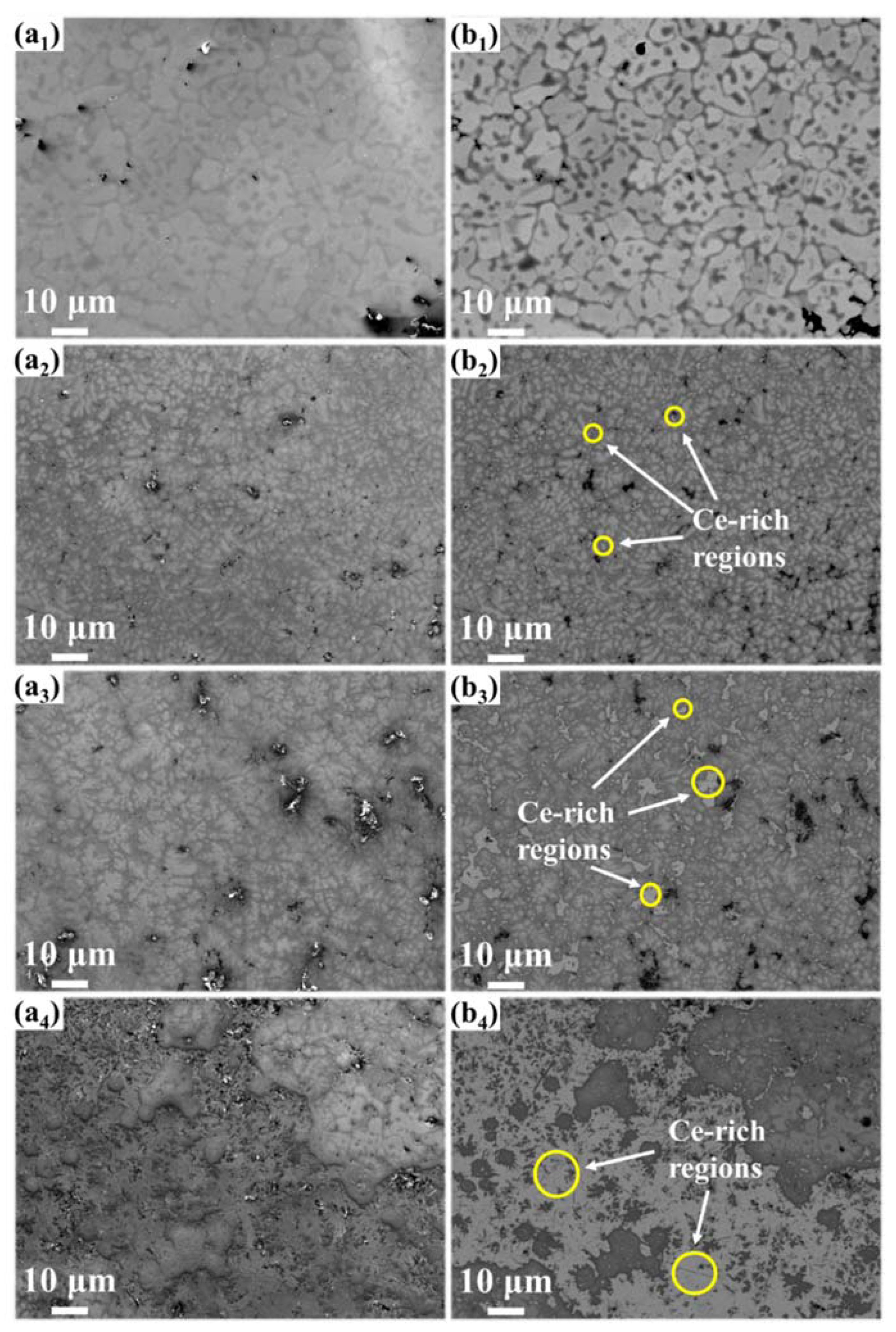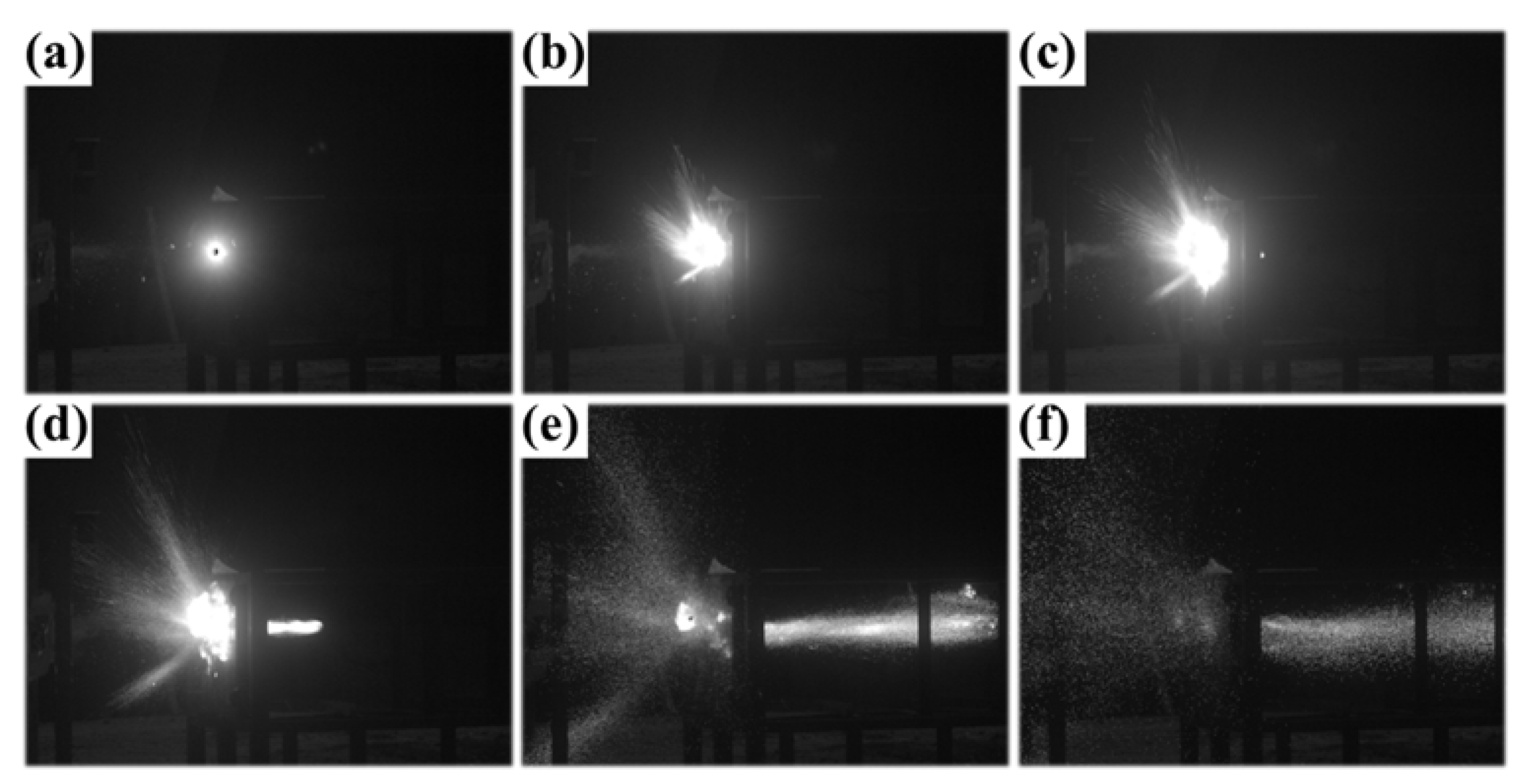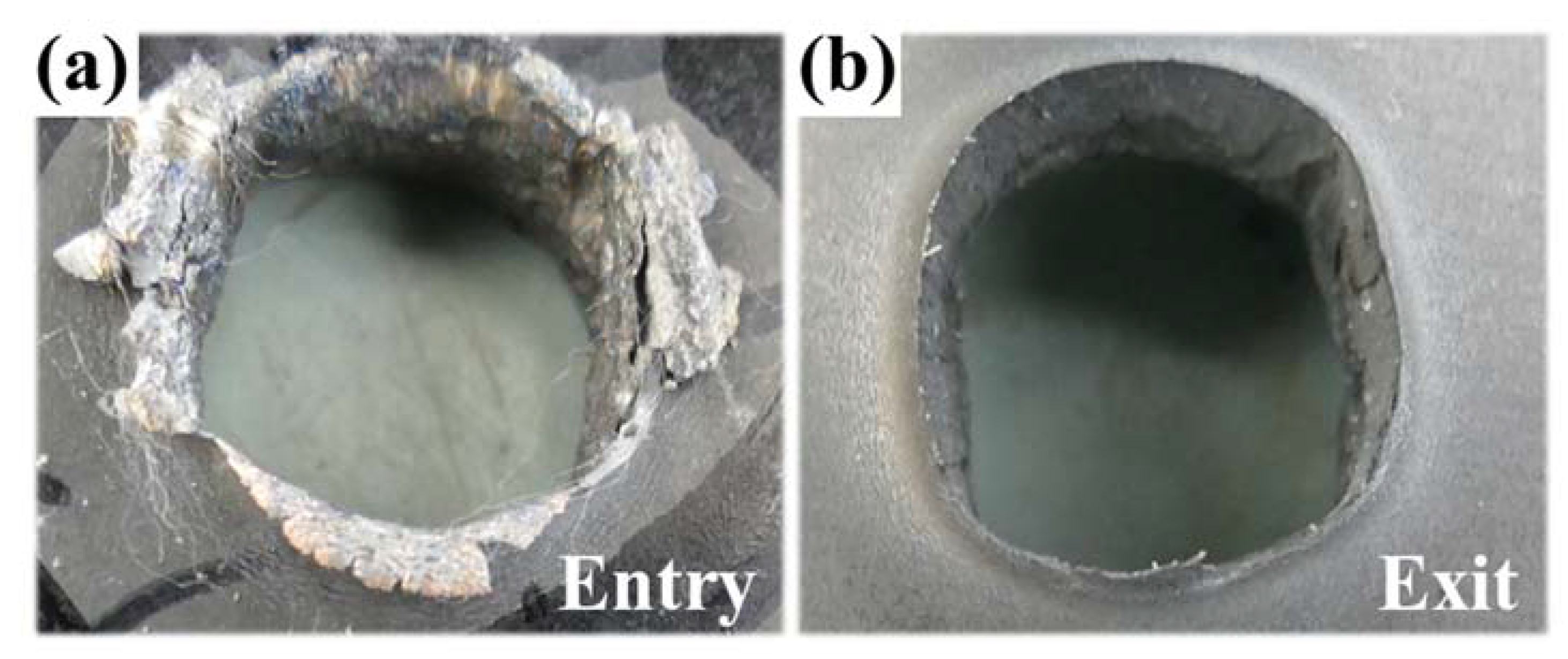Effects of Cerium Doping on the Mechanical Properties and Energy-Releasing Behavior of High-Entropy Alloys
Abstract
:1. Introduction
2. Materials and Methods
2.1. Preparation of Al0.5NbZrTi1.5Ta0.8Cex High-Entropy Alloy
2.2. Microstructure Characterization
2.3. Performance Test
3. Results and Discussion
3.1. Microstructures
3.2. Mechanical Properties
3.3. Energetic Characteristics
3.3.1. Dynamic Compression Process
3.3.2. Ballistic Performance
4. Conclusions
- (1)
- The XRD patterns indicate that the matrix had a BCC structure. Cerium doping resulted in the appearance of FCC structure in the alloys. The SEM and EDS illustrated dendritic morphology and element segregation was present in the alloy. The TEM images showed the presence of regions rich in Al, Nb, Zr, Ti and Ta with BCC structures and regions rich in Ce with FCC-structure regions and dislocations in the alloy.
- (2)
- The cerium-atom percentage has a significant influence on mechanical properties and energy-releasing behavior. As the cerium-atom percentage increased from 5 at. % to 25 at. %, the dynamic compressive yield strength and ultimate compressive strength showed a generally decreasing trend. The fracture strain of the Ce5 and Ce10 ranged from 9% to 10%, increasing to 19% of the Ce25 because of the continuous Ce-rich regions with FCC structures. According to the images from the high-speed camera, cerium doping improved the energy-releasing characteristics. As the content of cerium increased, the reaction-delay time became shorter. The time to reach the most violent reaction shortened and the energy-release reaction became more violent.
- (3)
- Al0.5NbZrTi1.5Ta0.8Ce0.25 can penetrate 6-millimeter A3 plates at a speed of 729 m/s and ignite cotton behind a target. It is an ideal energetic structural material because of its combination of excellent mechanical properties and energetic characteristics.
Author Contributions
Funding
Institutional Review Board Statement
Informed Consent Statement
Data Availability Statement
Conflicts of Interest
References
- Montgomery, H.E. Reactive Fragment. 1976. Available online: https://www.patenthub.cn/patent/US3961576A.html?ds=us&ds=us&dm=mix&p=1&ps=10&s=score!&m=none&q=Reactive%20fragment#/basic (accessed on 8 June 1976).
- Tang, E.; Sun, Z.; Han, Y.; Yu, W.; Chen, C.; Xu, M.; Chang, M.; Guo, K.; He, L. Dynamic characteristics of enhanced Al/PTFE and real-time quantitative evaluation of impact release energy under vacuum environment. Results Phys. 2021, 31, 105019. [Google Scholar] [CrossRef]
- Tang, E.; Li, S.; Chen, C.; Han, Y. Dynamic compressive behavior of fiber reinforced Al/PTFE active materials. J. Mater. Res. Technol. 2020, 9, 8391–8400. [Google Scholar] [CrossRef]
- Cheng, J.; Hng, H.; Lee, Y.; Du, S.; Thadhani, N. Kinetic study of thermal- and impact-initiated reactions in Al–Fe2O3 nanothermite. Combust. Flame 2010, 157, 2241–2249. [Google Scholar] [CrossRef]
- Ren, H.; Liu, X.; Ning, J. Microstructure and mechanical properties of W-Zr reactive materials. Mater. Sci. Eng. A 2016, 660, 205–212. [Google Scholar] [CrossRef]
- Zhou, Q.; Hu, Q.; Wang, B.; Zhou, B.; Chen, P.; Liu, R. Fabrication and characterization of the Ni–Al energetic structural material with high energy density and mechanical properties. J. Alloys Compd. 2020, 832, 154894. [Google Scholar] [CrossRef]
- Senkov, O.N.; Senkova, S.V.; Woodward, C. Effect of aluminum on the microstructure and properties of two refractory high-entropy alloys. Acta Mater. 2014, 68, 214–228. [Google Scholar] [CrossRef]
- Moazzen, P.; Toroghinejad, M.R.; Zargar, T.; Cavaliere, P. Investigation of hardness, wear and magnetic properties of NiCoCrFeZrx HEA prepared through mechanical alloying and spark plasma sintering. J. Alloys Compd. 2021, 892, 161924. [Google Scholar] [CrossRef]
- Zhang, P.; Xu, Z.; Yao, Z.; Liu, Y.; Lin, S.; He, M.; Lu, S.; Wu, X. A high-corrosion-resistant high-entropy alloys (HEAs) coatings with single BCC solid solution structure by laser remelting. Mater. Lett. 2022, 324, 132728. [Google Scholar] [CrossRef]
- Zhang, Z.; Zhang, H.; Tang, Y.; Zhu, L.; Ye, Y.; Li, S.; Bai, S. Microstructure, mechanical properties and energetic characteristics of a novel high-entropy alloy HfZrTiTa0.53. Mater. Des. 2017, 133, 435–443. [Google Scholar] [CrossRef]
- Zhouran, Z. Microstructure and Mechanical Properties of HfZrTiTax High-Entropy Alloys Energetic Structural Materials. Master’s Thesis, National University of Defense Technology, Changsha, China, 2017. [Google Scholar]
- Wang, R.; Tang, Y.; Li, S.; Zhang, H.; Ye, Y.; Zhu, L.; Ai, Y.; Bai, S. Novel metastable engineering in single-phase high-entropy alloy. Mater. Des. 2019, 162, 256–262. [Google Scholar] [CrossRef]
- Haihua, C.; Xianfeng, Z.; Wei, X.; Chuang, L.; Haiyang, W.; Haiying, W.; Lanhong, D. Dynamic Mechanical Behavior and Penetration Performance of WFeNiMo High-Entropy Alloy. Chin. J. Theor. Appl. Mech. 2020, 52, 1443–1453. [Google Scholar] [CrossRef]
- Hou, X.W.; Xiong, W.; Chen, H.H.; Zhang, X.F.; Wang, H.Y.; Dai, L.H. Impact Energy Release and Damage Characteristics of Two High-Entropy Alloys. Chin. J. Theor. Appl. Mech. 2021, 53, 2528–2540. [Google Scholar] [CrossRef]
- Ren, K.; Liu, H.; Chen, R.; Tang, Y.; Guo, B.; Li, S.; Wang, J.; Wang, R.; Lu, F. Compression properties and impact energy release characteristics of TiZrNbV high-entropy alloy. Mater. Sci. Eng. A 2021, 827, 142074. [Google Scholar] [CrossRef]
- Fu, T.; Sun, X.; Ge, C.; Xie, D.; Li, J.; Pan, H.; Qin, G. Achieving high strength-ductility synergy in dilute Mg-Al-Ca alloy by trace Ce addition. J. Alloys Compd. 2022, 917, 165407. [Google Scholar] [CrossRef]
- Jin, H.; Sui, Y.; Yang, Y.; Jiang, Y.; Wang, Q. Effect of Ce content on the microstructure and mechanical properties of squeeze-cast Al–5Mg-2.2Si-0.6Mn alloys. J. Mater. Res. Technol. 2022, 19, 1798–1804. [Google Scholar] [CrossRef]
- Ye, Y.; Wang, Q.; Zhao, Y.; He, Q.; Lu, J.; Yang, Y. Elemental segregation in solid-solution high-entropy alloys: Experiments and modeling. J. Alloys Compd. 2016, 681, 167–174. [Google Scholar] [CrossRef]
- Shang, L.; Jung, I.; Yue, S.; Verma, R.; Essadiqi, E. An investigation of formation of second phases in microalloyed, AZ31 Mg alloys with Ca, Sr and Ce. J. Alloys Compd. 2010, 492, 173–183. [Google Scholar] [CrossRef]
- Wang, G.; Huang, G.; Chen, X.; Deng, Q.; Tang, A.; Jiang, B.; Pan, F. Effects of Zn addition on the mechanical properties and texture of extruded Mg-Zn-Ca-Ce magnesium alloy sheets. Mater. Sci. Eng. A 2017, 705, 46–54. [Google Scholar] [CrossRef]
- Wei, X.; Liu, Y.; Yu, Y.; Zhang, X.; Hodgson, P. Hybrid effect of stress state and strain rate on the deformation and ductile fracture behaviour of TRIP800 steel sheet. Mater. Sci. Eng. A 2021, 833, 142533. [Google Scholar] [CrossRef]
- Yin, T.; Shen, Y.; Xue, W.; Jia, N.; Zuo, L. Ce addition enabling superior strength and ductility combination of a low-carbon low-manganese transformation-induced plasticity steel. Mater. Sci. Eng. A 2022, 849, 143474. [Google Scholar] [CrossRef]
- Walley, S.M.; Field, J.E.; Greenaway, M.W. Crystal sensitivities of energetic materials. Mater. Sci. Technol. 2006, 22, 402–413. [Google Scholar] [CrossRef]









| Element | Region I (at. %) | Region s (at. %) | Region III (at. %) |
|---|---|---|---|
| Al | 4.5 | 9.0 | 7.6 |
| Nb | 28.3 | 21.9 | 4.1 |
| Zr | 11.3 | 21.5 | 3.1 |
| Ti | 27.0 | 31.4 | 5.4 |
| Ta | 28.5 | 16.0 | 6.0 |
| Ce | 0.4 | 0.3 | 73.9 |
| Element | Region Ⅳ (at. %) | Region Ⅴ (at. %) |
|---|---|---|
| Al | 4.9 | 0.0 |
| Nb | 23.4 | 2.5 |
| Zr | 25.4 | 2.4 |
| Ti | 29.8 | 2.9 |
| Ta | 15.7 | 1.1 |
| Ce | 0.8 | 91.1 |
Publisher’s Note: MDPI stays neutral with regard to jurisdictional claims in published maps and institutional affiliations. |
© 2022 by the authors. Licensee MDPI, Basel, Switzerland. This article is an open access article distributed under the terms and conditions of the Creative Commons Attribution (CC BY) license (https://creativecommons.org/licenses/by/4.0/).
Share and Cite
Ma, Y.; Zhou, L.; Zhang, K.; Gai, X.; He, J.; Zhang, X. Effects of Cerium Doping on the Mechanical Properties and Energy-Releasing Behavior of High-Entropy Alloys. Materials 2022, 15, 7332. https://doi.org/10.3390/ma15207332
Ma Y, Zhou L, Zhang K, Gai X, He J, Zhang X. Effects of Cerium Doping on the Mechanical Properties and Energy-Releasing Behavior of High-Entropy Alloys. Materials. 2022; 15(20):7332. https://doi.org/10.3390/ma15207332
Chicago/Turabian StyleMa, Yusong, Liang Zhou, Kaichuang Zhang, Xiqiang Gai, Jinyan He, and Xinggao Zhang. 2022. "Effects of Cerium Doping on the Mechanical Properties and Energy-Releasing Behavior of High-Entropy Alloys" Materials 15, no. 20: 7332. https://doi.org/10.3390/ma15207332
APA StyleMa, Y., Zhou, L., Zhang, K., Gai, X., He, J., & Zhang, X. (2022). Effects of Cerium Doping on the Mechanical Properties and Energy-Releasing Behavior of High-Entropy Alloys. Materials, 15(20), 7332. https://doi.org/10.3390/ma15207332





